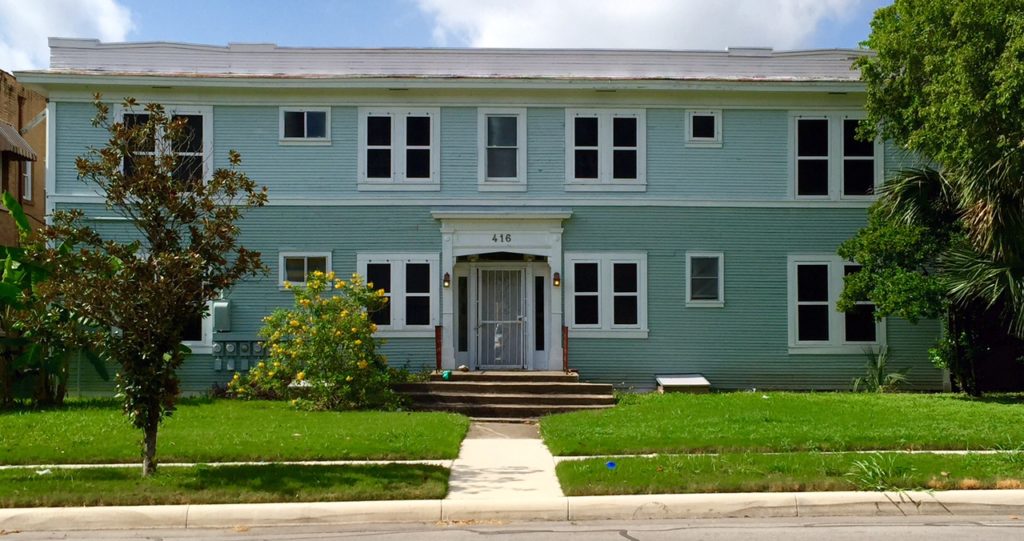If you’re anything like me, you enjoy having options. When it comes to coffee, for instance, I prefer a half-regular-half-decaf mocha, extra hot. Some days I make my own mocha, while other days I choose my chocolate creation from a growing cache of local caffeinators. Occasionally, I’ll even change it up and get my coffee iced or with almond milk.
When it comes to our homes, however, we don’t have the same menu of options. For the vast majority of us, either we elect to live in a large apartment complex or we seek out the detached single-family home in a community filled mostly with other detached single-family homes. And, the tighter our budget, the more limited those options become.
But, it wasn’t always that way.
As nearly 20 people discovered on Friday during San Antonio’s first-ever Missing Middle Housing Tour, our pre-World War II neighborhoods are filled with beautiful homes that do not fit the mold used by today’s production homebuilders. They are the oft-forgotten housing types between the detached single-family home and the standard apartment or condominium building—hence the term, “Missing Middle.” Neighborhoods like Mahncke Park, Monte Vista, and Monticello Park are home to duplexes, fourplexes, small apartment buildings, bungalow courts, and accessory dwelling units (better known as “Granny Flats”) that offer living solutions for the growing number of households who would gladly trade square footage for walkable amenities.

This Alamo Heights home features a second dwelling unit at the back of the property, an ideal space for extended family as well as young professionals.
Just how many households would make that trade for the Missing Middle, anyway? For starters, roughly one in four San Antonians live alone, or about 185,000, according to the U.S. Census. That is nearly equal to the number of nuclear family households in the metro area that include two parents and children. Many of these single-person households—young professionals, college students, empty nesters, and senior citizens alike—all continue to express a desire to live in walkable, mixed-use communities.
Back in 2010, we set created a vision for our city as part of SA2020 that included increasing walkability by the year 2020. And, initial reports from the City’s SA Tomorrow comprehensive plan confirm it: “San Antonio lacks walkable neighborhoods that fit with changing consumer preferences, as only 14% of the City’s neighborhoods have a Walk Score indicating a walkable neighborhood.” This SA2020 indicator shows that our city Walk Score is getting worse.
Perhaps a more important consideration than just the conveniences that come with Missing Middle housing is the large number of families who need Missing Middle housing. Seven percent of our families lack access to a car; that number jumps to nearly 16 percent for single-person households. This signals a strong need not only for walkable neighborhoods, but also for reliable, frequent public transportation—something a transit agency can only offer when population density supports it. The beauty of Missing Middle housing is that it provides the density to support great transit service, all while busting the myth that density is only achieved by building high-rises.
Developers are beginning to see opportunities in Missing Middle housing and are now looking to fill that market niche in central San Antonio neighborhoods. Terramark Urban Homes has already built several clustered homes in existing neighborhoods like Tobin Hill and Lone Star, while Mitch McManus recently completed a small, 17-unit condominium project in Government Hill. Stephen Horton has developed small-scale Missing Middle projects in Tobin Hill and Beacon Hill, and locally-based AREA Real Estate is planning to build the city’s first micro apartments just north of downtown.
Still, attendees of Friday’s housing tour brought up some interesting points to debate during the morning’s conversation. Several participants wondered aloud whether Missing Middle housing should cater primarily to renters or to homeowners (I would argue for both). Others, including local developer David Adelman, shared concerns about why more of the demand for these housing types isn’t being met:
“Both the cost of land [in urban neighborhoods] and the cost of redevelopment are relatively high, which then makes the barrier to entry high for investment,” Adelman said. This tends to limit interest by large-scale developers who typically plan for projects with hundreds of units, leaving smaller investors to the task of providing Missing Middle and other infill housing.

“Both the cost of land [in urban neighborhoods] and the cost of redevelopment are relatively high, which then makes the barrier to entry high for investment,” Adelman said. This tends to limit interest by large-scale developers who typically plan for projects with hundreds of units, leaving smaller investors to the task of providing Missing Middle and other infill housing.
Among Friday’s group, though, there seemed to be optimism about the role of Missing Middle housing in San Antonio’s future, despite 60 years of building without it. It’s as though we have only been asking, “Do you want your coffee with cream or without?”
Thankfully, however, we can now look to our own past—in our own backyards, even—to find a whole menu of choices that can house the Alamo City of the future.


